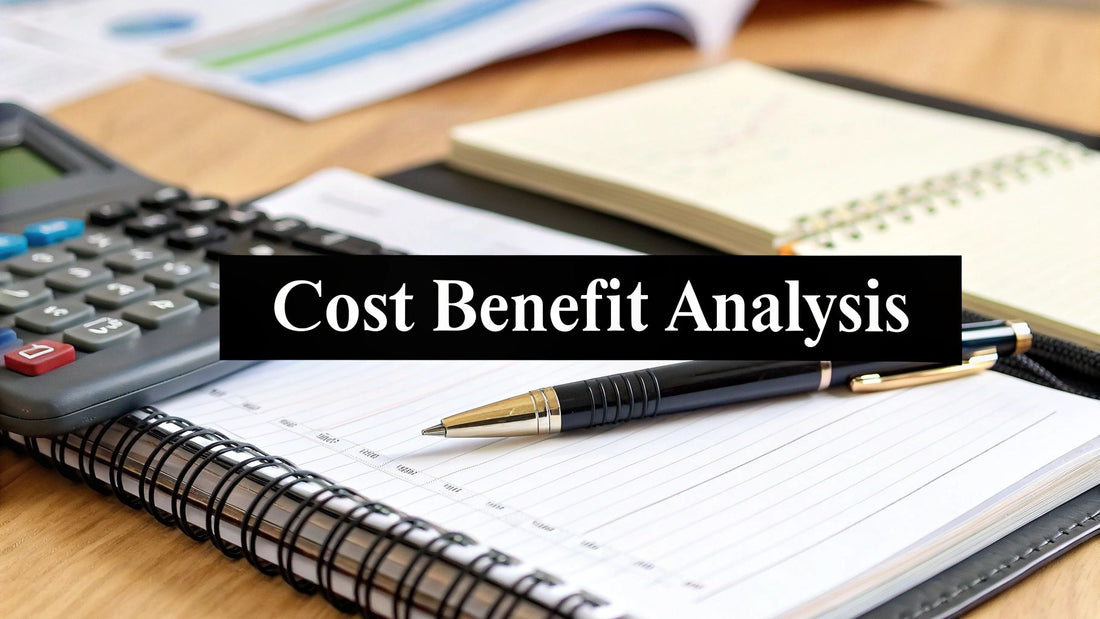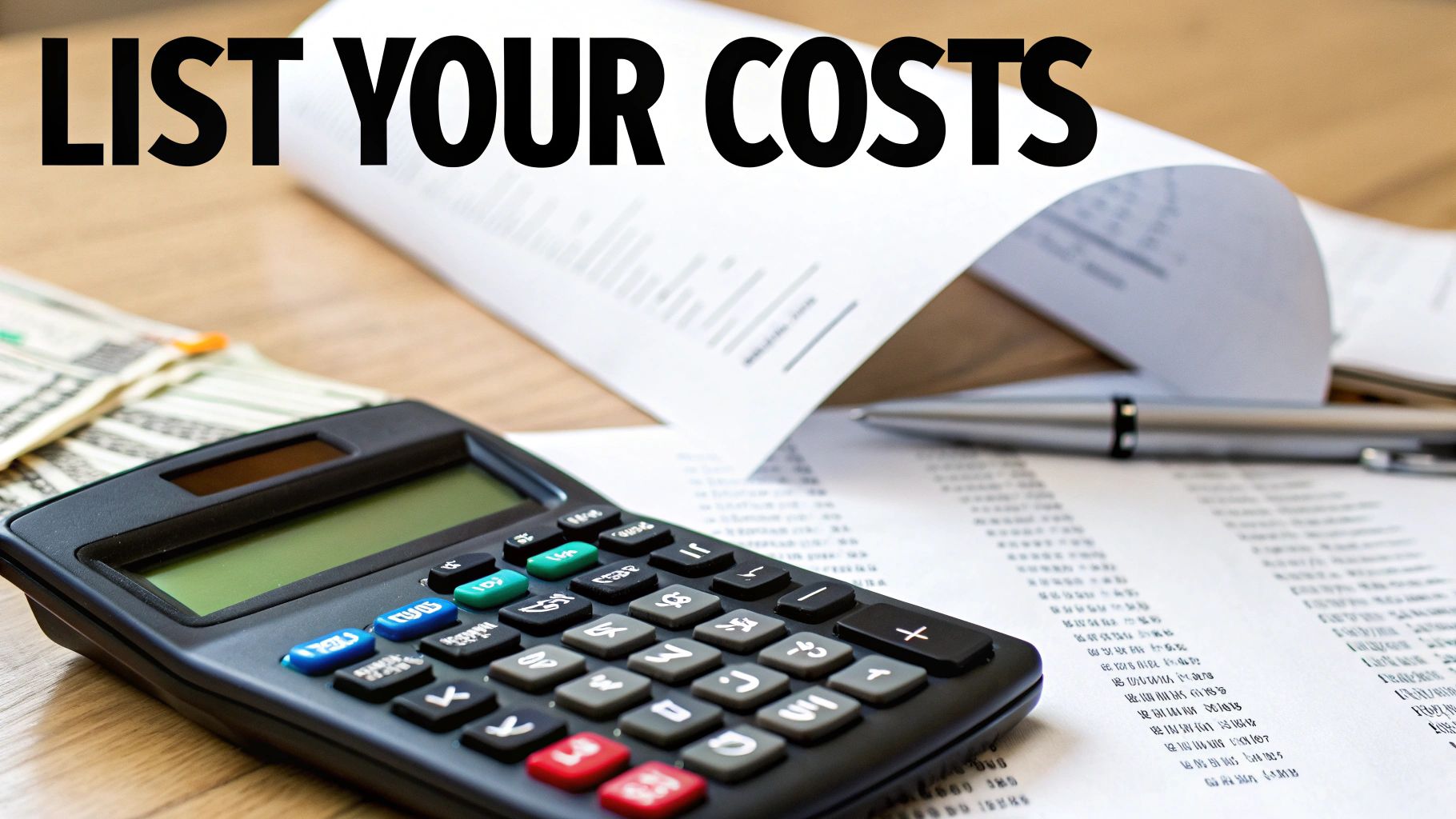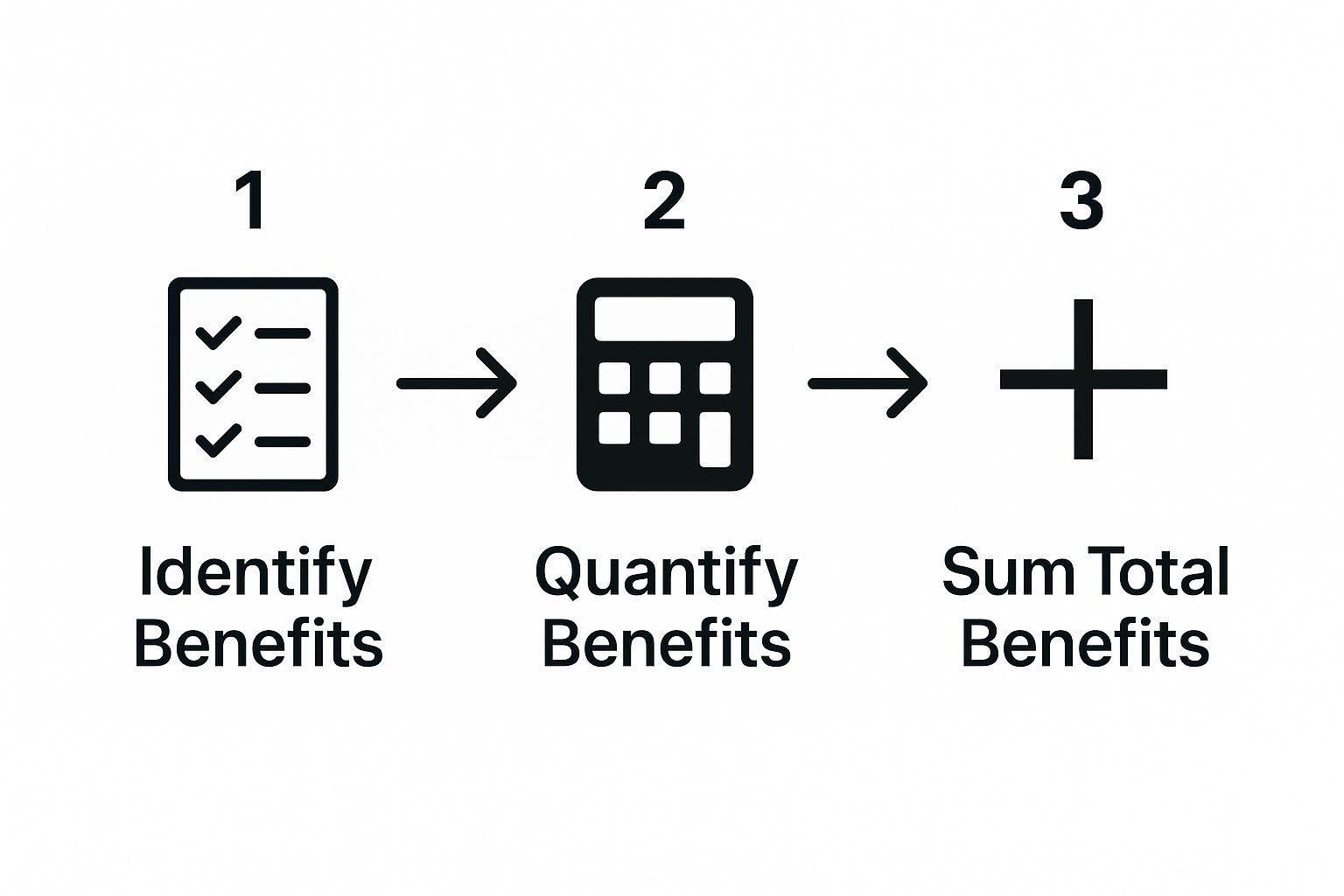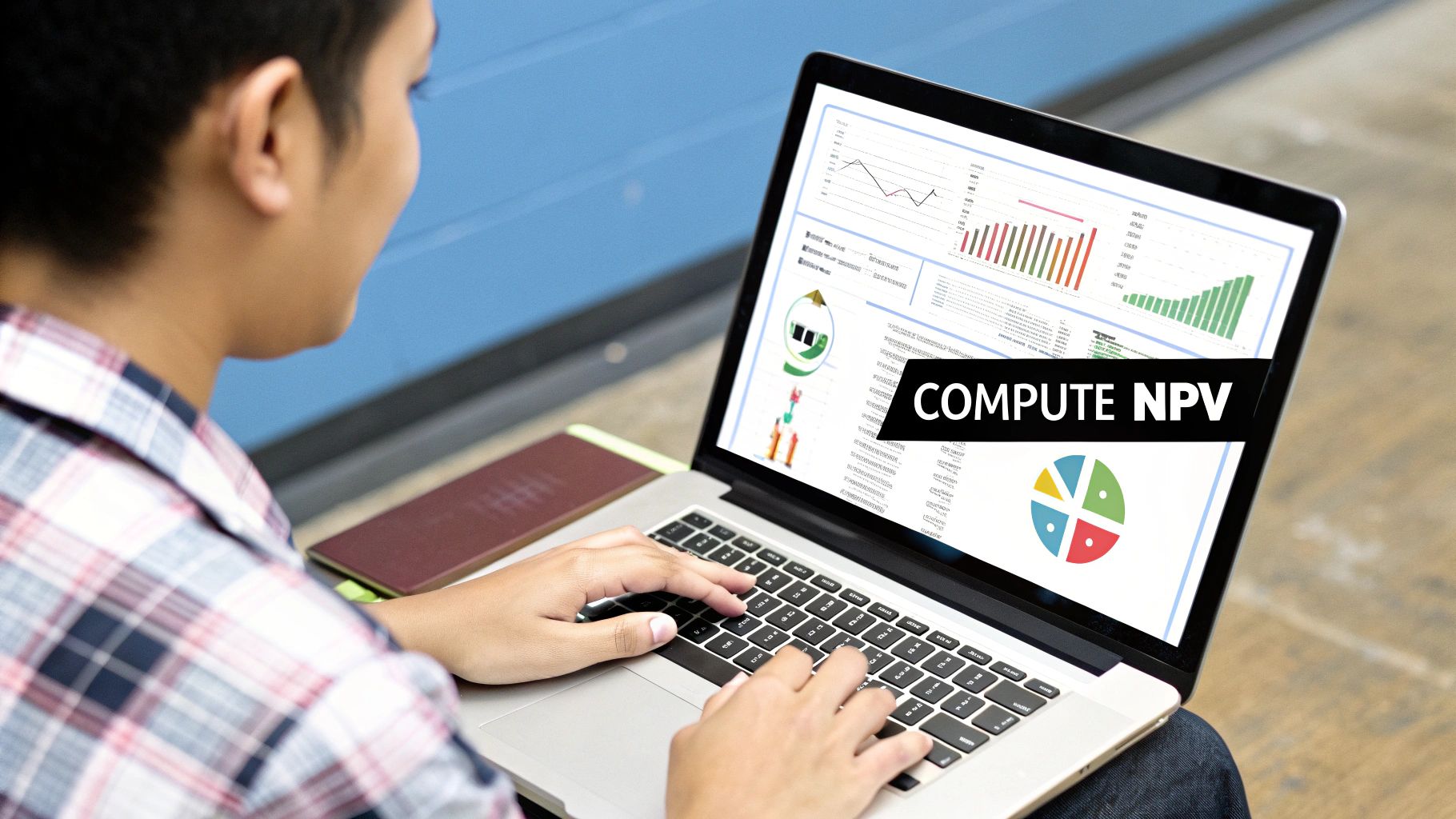
Your Guide to a Cost Benefit Analysis Template
Share
Staring down a big decision—like whether to invest in new software or greenlight a major project—can be daunting. It’s easy to get stuck in a loop of guesswork. A cost–benefit analysis template cuts through that noise, giving you a structured framework to make a smart, data-driven choice.
Think of it as your strategic roadmap. It helps you line up every single potential cost and weigh it directly against every expected benefit.
Making Clear Decisions with Your Template
A cost–benefit analysis (CBA) isn't just about crunching numbers. It's a powerful tool for finding clarity when things get complicated. When you have multiple options on the table, each with its own tangled web of pros and cons, relying on a gut feeling is a risky move. You need a systematic way to look at the situation objectively, and that’s where a good template is indispensable.

This guide will walk you through exactly how to use a cost–benefit analysis template to turn complex choices into confident actions.
Why a Template Is So Important
Jumping into an analysis from scratch is tough. A pre-built template turns an abstract idea into a concrete task, giving you an immediate starting point and a clear path forward. It provides a consistent framework that ensures you don’t overlook anything critical.
- Avoids Expensive Oversights: A template forces you to think through all the potential costs, not just the obvious ones. This systematic approach helps you spot the hidden expenses and indirect costs that can derail a project or purchase down the line.
- Helps You Justify Your Choice: Need to convince stakeholders, your boss, or your team? A completed CBA is your best evidence. It lays out a clear, logical argument showing exactly why one option delivers more value than the others.
- Creates Consistency: When you use the same template for different projects, you can make fair, apples-to-apples comparisons. This consistency is key for prioritizing initiatives and putting your resources where they’ll have the biggest impact.
At its core, a cost–benefit analysis template is about turning ambiguity into a clear balance sheet. It helps you separate the “what ifs” from the “what is,” giving you a solid foundation for your strategic decisions.
Ultimately, the goal is simple: pick the path that brings the most value to your organization. This structured approach helps you identify that path with confidence and explain its benefits to everyone involved. Let's dive into the key components you'll be working with.
Key Parts of a Cost Benefit Analysis Template
A solid template breaks the analysis down into manageable pieces. Here’s a quick overview of the essential components you'll use to weigh your options and make an informed decision.
| Component | Description | Example |
|---|---|---|
| Project Description | A clear, concise summary of the decision or project being analyzed. | Implementing a new CRM system to centralize customer data. |
| Costs (One-time & Recurring) | A detailed list of all negative impacts, both financial and non-financial. | Software subscription fees, employee training time, data migration costs. |
| Benefits (Tangible & Intangible) | A complete list of all positive outcomes, including those with and without a direct monetary value. | Increased sales productivity (tangible), improved team morale (intangible). |
| Timeline | The timeframe over which the costs will be incurred and the benefits will be realized. | Costs are highest in Year 1; benefits grow steadily over 3-5 years. |
| Net Benefit / ROI | The final calculation that subtracts total costs from total benefits to determine the overall value. | $150,000 in benefits - $50,000 in costs = $100,000 Net Benefit. |
Each of these sections works together to give you a complete picture, ensuring no stone is left unturned as you evaluate your options.
Understanding the Anatomy of Your Analysis
Think of a cost-benefit analysis template as a simple balance scale. On one side, you pile up everything you have to put in—all the costs. On the other side, you stack up everything you expect to get out—all the benefits. The whole point is to see which side is heavier.

This simple structure turns a knotty decision into a straightforward, visual comparison. To see how this works in the real world, let's walk through a common business decision: deciding whether to upgrade your company's Customer Relationship Management (CRM) system.
The Cost Side of the Equation
When we talk about costs, we're not just talking about the price tag. A proper analysis has to dig deeper and account for every expense, from the painfully obvious to the ones hiding in the shadows. Breaking them down makes it much harder to miss something important.
-
Direct Costs: These are the easy ones—the expenses directly tied to the project. For our CRM upgrade, that's the $20,000 annual software subscription and the one-time $5,000 fee to get all our data moved over.
-
Indirect Costs: These are the shared expenses needed to make the project happen. Think about the salaried employee time spent on training and implementation, which might add up to $10,000. Getting this right is where knowing different cost allocation methods really pays off.
-
Intangible Costs: These are the non-monetary impacts that can still sting. A new CRM system could cause a temporary dip in productivity or team morale as everyone struggles to learn the new software. It’s a real cost, even if it doesn't show up on an invoice.
-
Opportunity Costs: This is a big one. It's the value of the road not taken. By spending $35,000 on this CRM, you're explicitly not investing that same money into, say, a new marketing campaign that could have potentially generated $50,000 in new leads.
A great cost-benefit analysis template forces you to look past the initial bill. It’s about cataloging every single resource the project will eat up—your money, your team's time, and your company's focus.
The Benefit Side of the Equation
Once you have a clear picture of the costs, it's time to shift your focus to the good stuff. Just like costs, benefits come in different flavors, and capturing them all is key to seeing the true potential of a project.
Here's how the benefits might stack up for our CRM upgrade:
-
Direct Benefits: These are the tangible, measurable wins. The new CRM is projected to boost sales by $75,000 a year simply because our lead tracking will be so much better.
-
Indirect Benefits: These are the valuable ripple effects that are a bit harder to pin down. More efficient workflows might save each salesperson five hours a week, freeing them up to focus on closing deals instead of fighting with clunky software.
-
Strategic Benefits: This is about the long game. A modern CRM improves the quality of your data, which leads to smarter business decisions down the road. It also gives you a leg up on the competition, strengthening your position in the market.
This process of weighing both the hard numbers and the softer, qualitative factors is what separates a good decision from a bad one. In fact, reviews of massive projects often find they fail because of bad data or personal bias. A well-built template acts as your guardrail, forcing you to find evidence for both sides of the scale.
A Practical Walkthrough of the CBA Process
Alright, you understand the building blocks. Now, let's put that cost-benefit analysis template to work. This is where the theory ends and the real-world decision-making begins, turning a complex choice into a clear, numbers-driven conclusion.
To make this tangible, we'll follow a common scenario: a growing e-commerce business is at a crossroads. Should they invest in their own warehouse or stick with their current third-party logistics (3PL) service? This isn't just about filling in a spreadsheet; it's a structured way to uncover the true value behind your options, starting with a good old-fashioned brainstorming session to get every possible cost and benefit down on paper.
Step 1: Identify and Quantify All Costs
First things first, let's tackle the "cost" side of the equation. Your job is to list every single expense you can think of—leave no stone unturned. You have to think bigger than just the sticker price and consider the direct, indirect, and even the intangible costs over a set period, like the next five years.
For our e-commerce business, the costs of an in-house warehouse might look like this:
- Direct Costs: This is the obvious stuff. Think the warehouse lease ($120,000/year), salaries for the new warehouse team ($150,000/year), and the one-time hit for equipment like shelving and forklifts ($50,000).
- Indirect Costs: Don't forget the operational expenses that keep the lights on. Utilities, insurance, and the software needed to manage inventory could easily tack on another $30,000 a year.
- Intangible Costs: What about the cost that doesn't show up on an invoice? The management team's time and attention will be pulled away from sales and marketing to get this new logistics operation running smoothly. That's a very real, albeit non-monetary, cost.
Getting a firm grip on your numbers is crucial here. To make sure your data is solid from the start, it helps to understand how to track business expenses effectively.
Step 2: Identify and Quantify All Benefits
With the costs mapped out, it's time to flip the coin and look at the benefits. This part can feel a bit more creative, especially when you have to put a dollar value on outcomes that aren't purely financial. But the goal is the same: translate every positive impact into a number.
This simple graphic breaks down the flow for thinking through the "benefit" side of your analysis.

Walking through these three stages ensures you capture everything from direct cash savings to softer, long-term gains, giving you a complete picture to weigh against your costs.
For our e-commerce company, the upsides could be:
- Direct Financial Gains: The most immediate win is cutting ties with their 3PL, saving them $180,000 a year in fees. They also project that faster, more accurate shipping will lead to fewer returns and happier customers, boosting revenue by an estimated $50,000 annually.
- Intangible Gains: Having total control over their inventory means better quality control, which in turn strengthens their brand reputation. How do you quantify that? You could estimate it leads to a 1% bump in customer retention, which translates to $20,000 in additional customer lifetime value.
Step 3: Aggregate and Compare
This is the moment of truth. You’ve done the hard work of digging up and quantifying all the costs and benefits over your chosen timeframe (we're using five years). Now, it's time to add it all up and see what the numbers say.
A cost-benefit analysis template is ultimately a tool for comparison. It translates assumptions and projections into a simple equation: Do the total benefits outweigh the total costs?
With your totals in hand, you can calculate key metrics like Return on Investment (ROI), Net Present Value (NPV), or the Payback Period.
For our e-commerce business, let's say the total five-year benefits come to $1,250,000 and the total costs add up to $950,000. That leaves a net benefit of a cool $300,000. This positive result gives them a strong, data-backed reason to go ahead and build their own warehouse.
Seeing Cost-Benefit Analysis in the Real World
Theory is one thing, but seeing a cost-benefit analysis template in action is where the lightbulb really goes on. It’s the moment abstract ideas about pros and cons become concrete tools for making smart decisions.
Let's walk through two very different examples to see just how flexible this framework can be. First, a classic business scenario, and then a situation where the "return on investment" isn't measured in dollars and cents.

Case Study 1: The Tech Startup
Imagine a fast-growing tech startup. They're weighing whether to build a major new feature for their flagship mobile app. The gut feeling is that it will boost user engagement and attract new paying customers, but gut feelings don't pay the bills. Is it a sound financial move?
This is the perfect job for a numbers-focused cost-benefit analysis.
The Costs:
- Direct Costs: This is the easy stuff. They’ve budgeted for three months of developer salaries ($90,000), extra server capacity ($5,000), and a marketing campaign to launch the feature ($25,000).
- Indirect Costs: The project manager and QA team will be pulled onto this project. While they're already on salary, their time has value. The company estimates this is worth about $15,000.
- Opportunity Cost: This is a big one. By working on the new feature, the dev team isn't fixing bugs or optimizing the existing app. They estimate that work could have reduced customer churn by 2%. That's a real, albeit hypothetical, cost.
The Benefits:
- Direct Benefits: Projections show the new feature should bring in $150,000 in new subscription revenue during the first year.
- Intangible Benefits: Beyond the cash, the company expects daily user engagement to jump by 15%. They also anticipate positive press, which strengthens their brand reputation.
Laying all this out in a template gives the startup a clear, data-driven picture. They can instantly see if the projected revenue justifies the total investment.
Case Study 2: The Nonprofit Organization
Now, let's pivot to a completely different world. A nonprofit wants to launch a community garden in a low-income neighborhood. Success here isn't about profit; it's about impact. This is where a good template proves its real worth—by helping to assign value to social good.
The true power of a cost-benefit analysis isn't just in crunching numbers. It's in forcing you to clearly define what "success" looks like, whether that's measured in dollars or in community well-being.
The Costs:
The costs are pretty straightforward: leasing the land, buying soil, tools, and seeds, plus a part-time coordinator's salary. It all adds up to $30,000 for the first year.
The Benefits (Intangible but Quantifiable):
- Improved Neighborhood Well-being: The nonprofit can use "proxy values" to put a number on this. For instance, they might research the impact on local property values (a potential 5% increase) or a measurable reduction in minor crime.
- Educational Opportunities: This can be quantified by tracking participation—say, the goal is to get 100 children involved in gardening workshops annually.
- Positive Media Coverage: What would it cost to buy the advertising space equivalent to a positive story in the local news? They estimate this PR value at $5,000.
When projects involve multiple partners sharing expenses, a solid framework becomes even more critical. If you need to structure that kind of arrangement, our guide on building a cost sharing agreement template can help.
In both cases, the template takes a big, messy question and gives it structure. The conversation shifts from a vague "should we do this?" to a focused "what is the tangible value this will create?" It ensures every decision is grounded in evidence, not just enthusiasm.
Why Smart Organizations Rely on This Method
A cost-benefit analysis is so much more than a simple calculation—it’s a fundamental piece of the strategic planning puzzle for any successful company. Making high-stakes decisions based on gut feelings or emotional reactions is a recipe for disaster. A cost-benefit analysis template cuts through that noise, giving you a structured framework to look at the hard data, plain and simple.
This disciplined approach means your decisions aren't just based on what feels right, but on what you can actually defend with evidence. It’s an incredibly powerful way to allocate precious resources, ensuring your budget and your team's time are channeled into projects that promise the biggest payoff. This is a cornerstone of effective https://accountshare.ai/blogs/new/strategic-cost-management.
Fostering Transparency and Accountability
When you document your cost-benefit analysis properly, you're not just guiding a decision; you're building trust. It hands leaders the concrete evidence they need to justify their choices to the board, investors, and other key stakeholders. This kind of transparency gets everyone aligned and pulling in the same data-supported direction.
The real power of a cost-benefit analysis is that it forces a conversation grounded in evidence. It moves the discussion from "I think we should" to "the data shows this is our best path forward."
This isn't just a corporate exercise. For over 40 years, this exact kind of analysis has been a cornerstone of U.S. regulatory policy. It’s how the federal government weighs whether the expected benefits of major regulations are worth the costs. This just goes to show how the method can clarify the true impact of incredibly complex choices.
Today, savvy organizations are taking it a step further by using advanced tools to sharpen their analysis. For example, integrating technologies like AI for financial analysis can significantly improve the accuracy of both cost and benefit projections, leading to smarter, more reliable decisions.
Ultimately, a documented analysis creates a clear record of the "why" behind every major move. This holds everyone accountable for the results they projected and helps build a culture where strategic thinking is the norm, not the exception.
Watch Out for These Common Mistakes That Can Skew Your Results
Even the most thorough cost-benefit analysis is only as good as the numbers and assumptions you feed it. It’s surprisingly easy to fall into a few common traps that can completely undermine your work, turning a powerful decision-making tool into a simple reflection of your own gut feelings.
The biggest pitfall by far is confirmation bias. We all do it—we subconsciously look for information that supports what we already believe or want to happen. If you’re secretly rooting for a particular project, you might find yourself inflating its potential benefits while conveniently glossing over the true costs. The result? A skewed analysis from the get-go.
Right alongside that is good old-fashioned over-optimism. It's human nature to hope for the best, but this can lead to wildly underestimating timelines and budgets while over-inflating the potential payoff. A little bit of healthy skepticism is your best friend here. Actively challenge your own sunny forecasts and maybe even ask a colleague to play devil's advocate. It keeps things grounded.
Don't Fall for the "Garbage In, Garbage Out" Trap
The old saying "garbage in, garbage out" is a perfect fit for cost-benefit analysis. The quality of your final result is 100% dependent on the quality of the data you start with. Here are a couple more critical errors to avoid:
- Forgetting the "Soft" Costs: It's easy to add up software licenses and salaries, but what about the hit to team morale during a tough transition? Or the extra hours managers will spend overseeing the new initiative? These "intangible" costs are real, and even if you have to estimate them, they belong in your analysis.
- Mismatched Timelines: Comparing the ROI of a one-year project to one that pays off over five years is a classic apples-to-oranges mistake. Make sure you’re looking at all your options through the same consistent timeframe to get a true comparison.
At its core, a cost-benefit analysis is more than just a spreadsheet; it's a tool for thinking strategically about the future. It gives leaders the confidence to invest in the right places, turning today's savings into tomorrow's growth.
This idea of reinvesting is a powerful one. A recent survey from Boston Consulting Group found that 67% of executives are planning to funnel money saved from efficiencies directly back into innovation and growth initiatives.
This shows how a solid analysis doesn't just help you make one decision—it can shape an entire company's strategy for the future.
Common Questions About Cost-Benefit Analysis
Even with a solid template, you're bound to run into a few tricky questions. Let's walk through some of the most common ones that come up when people are doing a cost-benefit analysis.
How Do You Put a Price on Intangible Benefits?
This is the classic head-scratcher. How can you assign a dollar value to something like "better team morale" or a "stronger brand reputation"? It feels a bit like trying to catch smoke, but it's not impossible. The trick is to use what are called proxy values.
Think of it this way: to estimate the value of an improved brand image, you could ask, "What would a marketing campaign cost to get us this same level of positive buzz?" For higher team morale, you could calculate the savings from reduced employee turnover—less money spent on recruiting, hiring, and training. It’s about finding a tangible cost that mirrors the intangible benefit.
What’s the Difference Between CBA and ROI?
It's easy to get these two mixed up, but the distinction is pretty simple. Think of your Cost-Benefit Analysis as the entire detective story, and Return on Investment (ROI) as the final reveal.
The CBA is the broad framework you use to map out all the costs and all the benefits. ROI is just one specific metric you calculate from that analysis. It answers the question: "For every dollar we put in, how much do we get back?"
In short, your CBA does all the heavy lifting, and ROI is one of its most important outputs.
How Far Into the Future Should My Analysis Look?
Picking the right timeframe is crucial. A project can look like a total money pit in year one but a genius move by year five. If your timeframe is too short, you might kill a great idea before it has a chance to pay off.
The golden rule here is to align the analysis period with the useful life of the asset or project. Buying a new piece of machinery that will last for 10 years? Your analysis should cover a 10-year period. Launching a software subscription service with a 3-year plan? A 3-year timeframe makes sense. This gives you a realistic, long-term view of your investment's true worth.
Ready to manage your subscriptions and shared accounts without the headache? AccountShare offers a smarter way to access premium services at a fraction of the cost. Start saving today by visiting https://accountshare.ai.
